ECU VOLKSWAGEN GOLF 2005 Owners Manual
[x] Cancel search | Manufacturer: VOLKSWAGEN, Model Year: 2005, Model line: GOLF, Model: VOLKSWAGEN GOLF 2005Pages: 444, PDF Size: 92.7 MB
Page 91 of 444
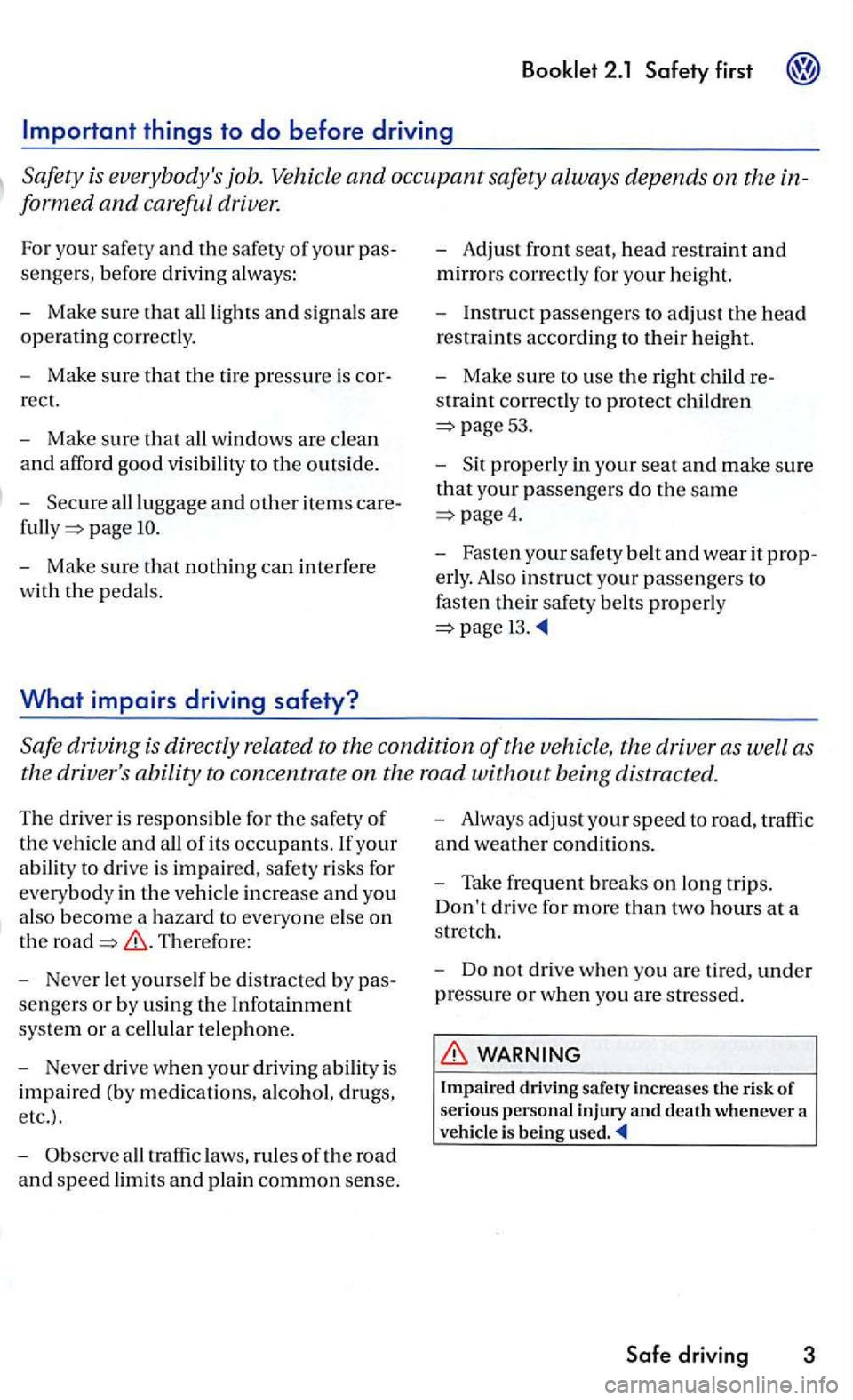
driver.
For your safety and the safety of your pas
sengers, before driving always:
- Make sure
that all lights and signals are
operating corr ect ly.
- Make su re
that the tire pres sure is cor
r
ect.
- Make sure that all windows are clean
and afford good visibility to the outside .
- Secure all luggage and
other items care
page
re
stra int correctly to protect children
53.
- S it properly in your seat and make sure
that your passengers do the same
4.
- Fasten your safety belt and wear it prop
erly. Also instruct your passenge rs to
fasten their safety belts properly
Safe driving is directly related to the condition of the vehicle, the driver as well as
the driver' s ability to concentra te on the road without being distracted.
The driver is responsible for the safety of
the vehi cle and all of its occupants. If your
ability to drive is impa ir ed, safety risks for
everybody in
the vehicle in crease and you
a lso becom e a hazard to everyo ne else
on
the There fo re:
- Never let yourse lf be di stracted by pas
sengers
or by using the Infotainm ent
syste m or a cellular tel ephone.
- Never drive w
hen your driving ability is
impa ired (by medication s, alco hol,
drugs,
etc.) .
- Observe a
ll traffic laws, rules of th e road
and speed limit s and plain common sense. -
Alway s
adjust you r speed to road, traffic
a
nd weathe r conditions.
- Take frequen t breaks on long trip
s.
Don't drive for more than two hours at a
s tretch.
-
Do n ot drive when you are tir ed, unde r
pressure
or when you are stresse d.
WARNING
Impaired driving safety increases the risk of serious personal injury and death whenever a
vehicle is being used
Page 94 of 444
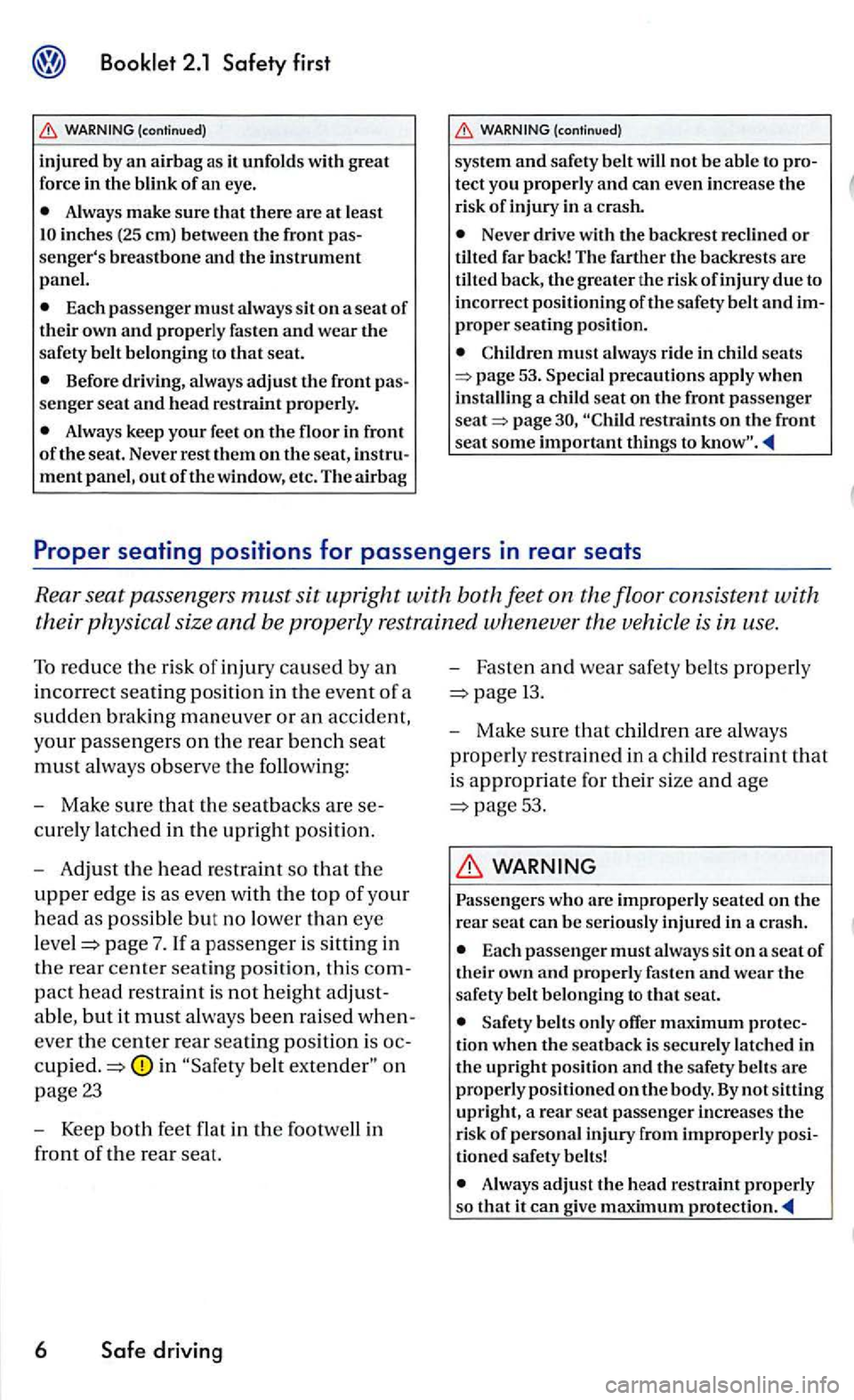
Always make sure that there are at least
Each passenger must always sit on a seat of their own and properly fasten and wear the safety belt be longing to that seat.
Before driving , always adjust the front senger seat and head re straint properly.
Alway s keep your feet on the floor in front of the seat. Never rest them on the seat, ment panel, out of the window, etc. The airbag
tect you properly and can even increa se th e
risk of injury in a crash.
Neve r drive with the backre st recl ined or tilted far back! The farth er the b ackrests are
tilted back, the greater the risk ofinjury due to
in correct positioning of the safety belt and
must always ride in seats 53. a child seat on the front passenger page
Mak e sure that the seatback s are
curel y lat ch ed in the upright position.
A djust th e head restraint so that the
upper edge is as even with the top of your
head as possible but no lower than eye
pag e 7. If a passe nger is s ittin g in
the rear center seating pos ition, this
pac t h ead restra int is not h eight
a ble , but it must always bee n rais ed
eve r the center rear seating posit ion is
belt on
page 23
Keep both feet flat in the footwell in
front
of the rear seat.
6 Safe driving
Fasten and wear safe ty belt s properly
13.
Make sure that children are always
prop e
rly restra in ed in a child re str aint that
is appropriate for thei r size and age
5 3 .
WARNING
Pas sengers who are improperly seated on the rear seat can be se riou sly injure d in a crash.
Each passen ge r must always sit on a seat of th eir own and properly fasten and wear the safety belt belonging to that seat.
belt s only offer maximum tion when the seat back is securely latched in
th e upright po siti on and the safety belts are
properly positioned on the body. By not sitting
upright , a re ar seat pass enger increases the risk of personal injury from improperl y
Always adjust the head restraint properly so that it can give maximum
Page 97 of 444
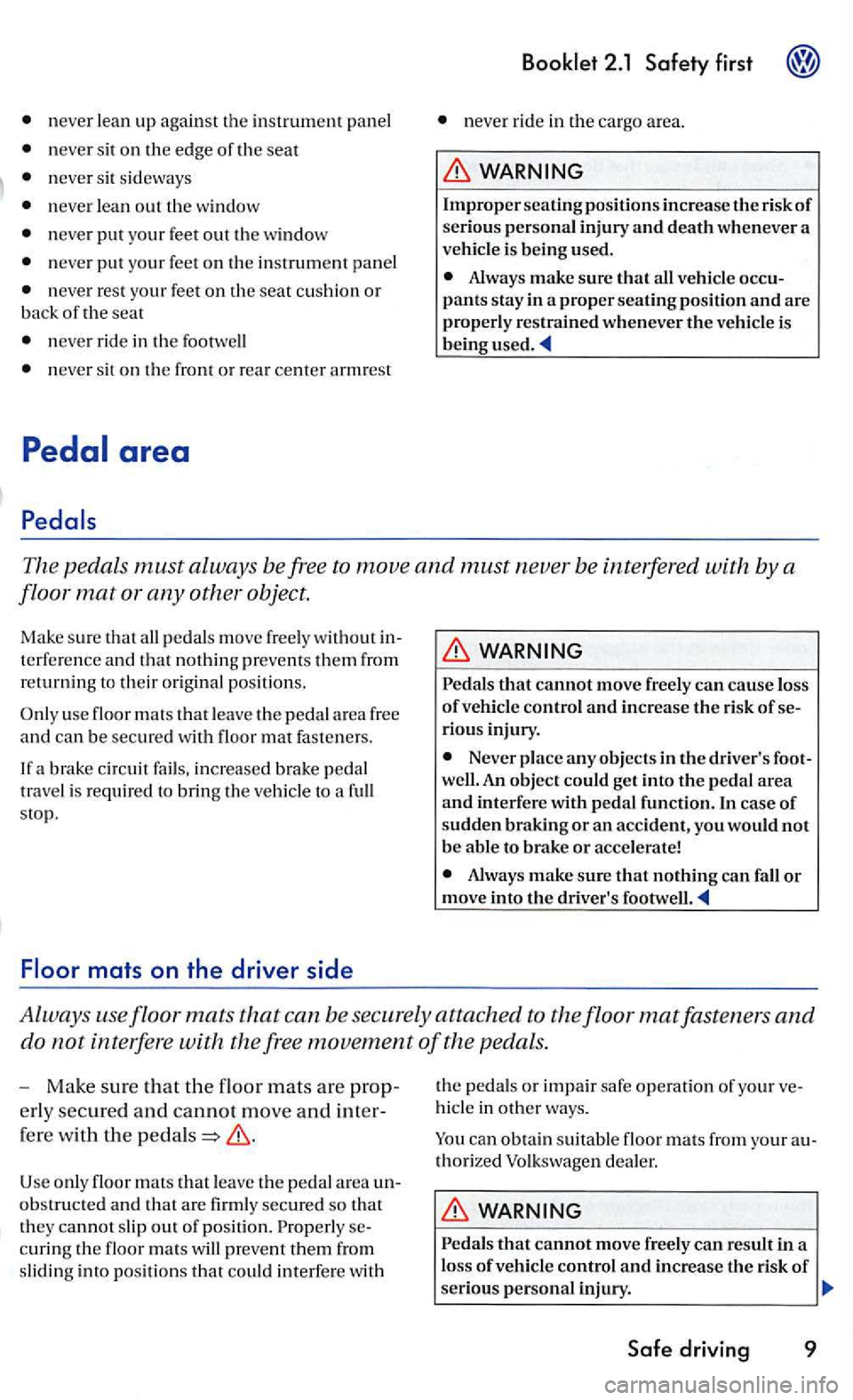
neve r lean up aga inst th e in strum ent pan el
n eve r sit on the edge of th e se at
neve r sit sid eways
neve r lean out th e w indow
neve r put your feet ou t th e w indo w
neve r put your feet on the in strument panel
neve r rest your feet o n the seat cu shion or back of th e sea t
never ride in the footwcll
n eve r sit o n th e front o r r ea r center armrest
first
n eve r rid e in th e ca rgo area.
WARNING
Improp er seating positions increase the risk of serious persona l injury and death w henever a
ve hicle is being used.
Alway s make sure that all vehicle occu
p ants stay in a proper seating position and are
properly res trained wheneve r the vehicle is
being used.
The pedals must always be free lo move and must never be in teJfered with by a
floor mat or any other object.
Make sure th at all ped als move freely without in
t e rf ere nce and that nothin g prevents th em from
r e turning to their origin al po sitions.
u se floor mats that le ave th e pedal area free and c a n be secured with floor mat f aste ners.
If a brak e cir cui t
fails, increa sed brake pedal trave l is req uired to brin g the vehicle to a full sto p.
WARNING
that cannot move freely can cause lo ss of vehicle control and increase the risk of se
riou s injury.
Neve r pla ce any objects in the driver's footwell. An object could get into the pedal area
and interf ere with pedal function . In case of sudden braking or an accident, you would not b e a ble to brake or acce le rat e!
Always make sure th at nothing ca n fall or move into the driver' s footwell.
Always use floor mats that can be securely a ttached to the floor mat fas tene rs and
do not inteJfe re with th e free movement of the pedals .
only floor mats that leave the ped al a rea un
ob structed and th at are firml y secured so that
th ey cannot slip out of po siti on. s e
c urin g th e floor mats will prevent them from
s lid ing into positi ons that could interfer e with th
e
pedals or im pair safe operatio n of your ve
hicl e in oth er ways.
You ca n obtain suitabl e floor mats from your au
th orized Volkswage n dea ler .
WARNING
Page 98 of 444
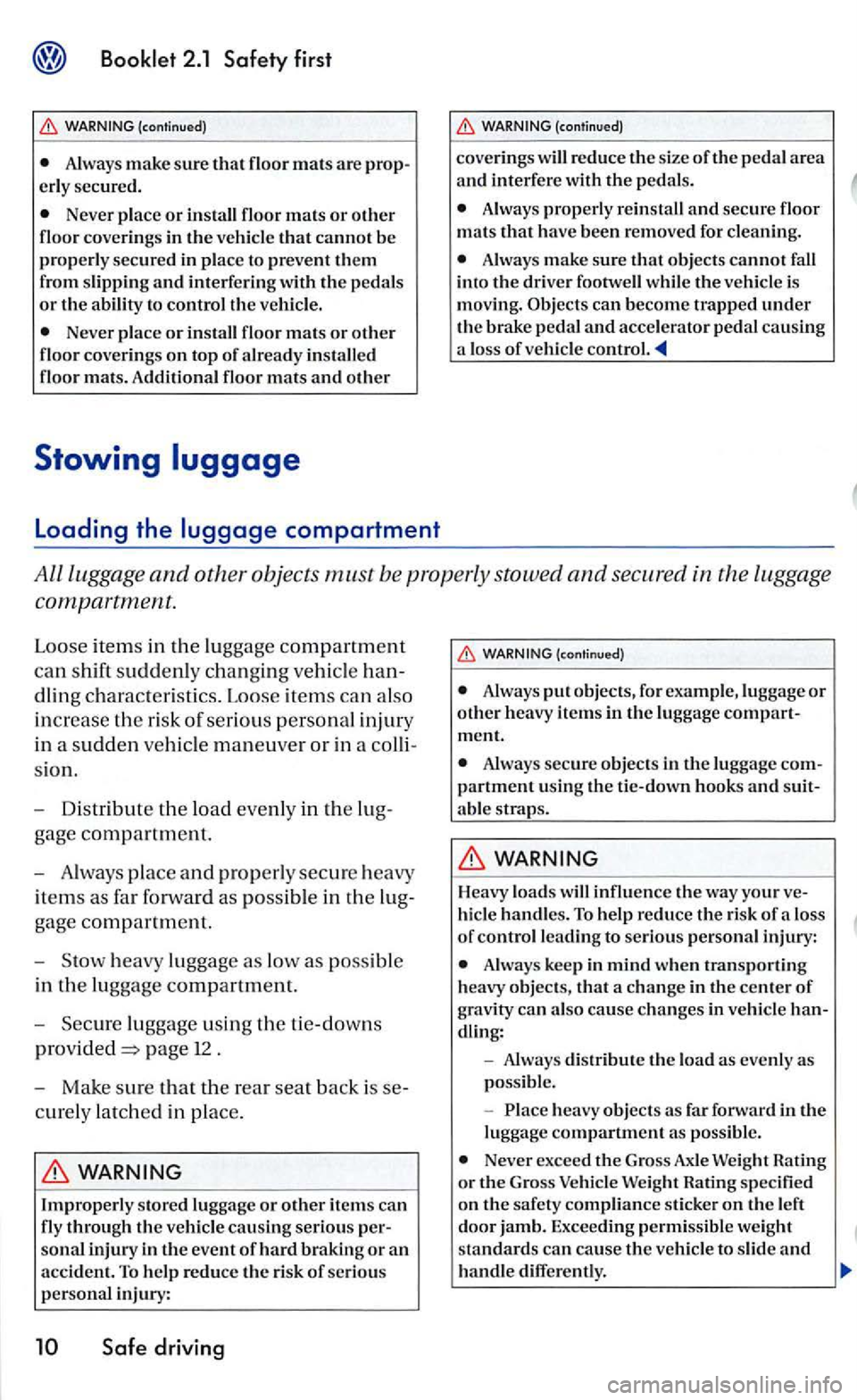
Always make sure that floor mats are erly secured.
Never place or install floor mats or other floor coverings in the vehicle that cannot be properly secured in place to prevent them
from slipping and interfering the pedals or the abiliry to control the vehicle.
Never place or install floor mats or other floor cover ings on top of already installed floor mats. Additional floor mats and other
Stowing
Loading the
(cont inued)
cove rings re d uce the s ize of the pedal area and interfe re with pedal s.
Always properly reinstall and secure floor mats that have been removed for cleaning.
Alway s m ake sure tl1at objects cannot fall
into
All luggage and other objects must be properly stowed and secured in the luggage
compartment.
Loose items in the luggage compartmen t
can shift suddenl y changing ve hicl e
in a sudden ve hicle maneuver o r in a
sion.
- Distribute th e lo ad eve nly in the
gage compartment.
- Always pla
ce and properly secure heavy
it
ems as far forward as possibl e in the
gage compartment.
-heavy luggage as low as possib le
in the lu ggage
compartment.
-
lu ggage using the tie-do wns
provided page 12 .
- Make sure
that th e rear seat b ack is
cure ly latched in plac e.
WARNING
Improperly stored lugg age or other item s can fly through the vehicle causing serious
(continued)
Always put objec ts, for example, luggag e or othe r heavy items in the lu ggage compartment.
Alwa ys secure objects in t11e lu ggage
able straps.
WARNING
Heavy loads influence the way your hicle handles . To help reduce the risk of a los s of control leading to serious personal injury:
Always keep in mind whe n transporting h eavy objects, that a c han ge in center of graviry can also cause changes in vehicle
heavy objects as far forward in the luggage compartment as poss ible.
Never excee d the Gross Axle Weig ht Rati ng
o r the Gross Vehicle Weig ht Rating specified on the safe ty compli ance stick er on the left door jamb. Exceeding pe rmissibl e w eig ht
sta ndards can cause the vehicle to slide and handle diff ere n tly.
Page 100 of 444
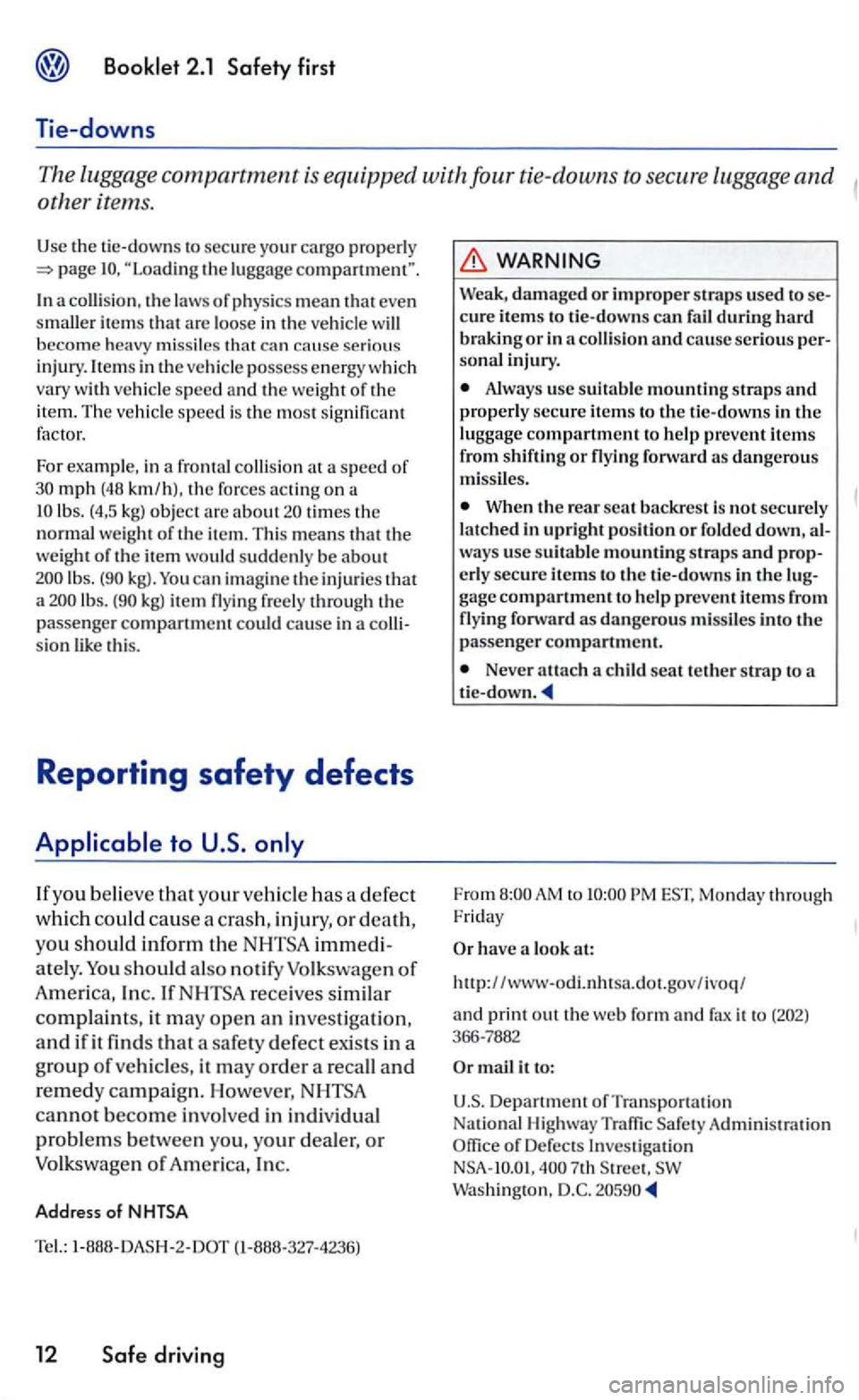
2.1 Saf ety fir s t
Tie-downs
The luggag e c
ompartment is equipped with four tie-downs to secu re luggage and
other it ems.
Use th e tie-downs to secu re you r cargo properly "Loa ding the lu ggage com part mem ".
a collisio n, th e law s of phy sics mean that even
s m aller items that are loose in the vehicle will become heavy missiles that ca n ca use serio us
i njury. h em s in the vehicle possess energ y which vary with vehicle speed and the we ight of the item . T he vehicle sp eed is th e mo st sig nifi cant factor.
For example, in a fronta l
collision at a speed of km /h), the forces acting on a times th e
n ormal weight of the item . Thi s means that the weigh t o f the it em wo uld suddenly be about lbs. kg). You can imagine the inj uries that lbs. kg) item f r ee ly through the passenger compartmem could cause in a
If yo u believe that your ve hicl e has a defec t
w hi
ch co uld ca use a c rash, injury, or death,
yo u sh ould inform the
ate ly. should also notify Volk swage n of
America, Inc. If receives similar
complaints, it may open an inves tigation ,
and if it finds that a safety defect exis ts in a
group of vehi cles, it may order a recall and
remedy campaign . H ow ever,
(1-888-327-42 36)
12 Safe driving
WARN ING
Weak, dam age d or improper strap s used to c ure item s to tie -downs can fail during hard or in a collision and cause serious sonal injury.
Alw ays use suitabl e mounting straps and properly secure item s to th e tic -downs in the luggage compartment to help prevent items from shifting or flying forward as dangerous
m issiles .
When th e re ar scat backre st is n o t securely
latched in upright posit ion or fo ld ed down,
erly secure items to the tie-downs in the g age compartment to help prevent items from
flyin g fonvard as dangerous missiles into the passenger compartment.
Never attach a child seat t eth er strap to a
From to Mo nday throug h
Frid ay
have a look at:
http://www-odi. nhtsa.dot.gov/ivoq/
and print out the web form and fax it to
m ail it to:
U
.S. Departmem of Tra nspo rtatio n Nationa l Highwa y
7th Wash ington,
Page 107 of 444
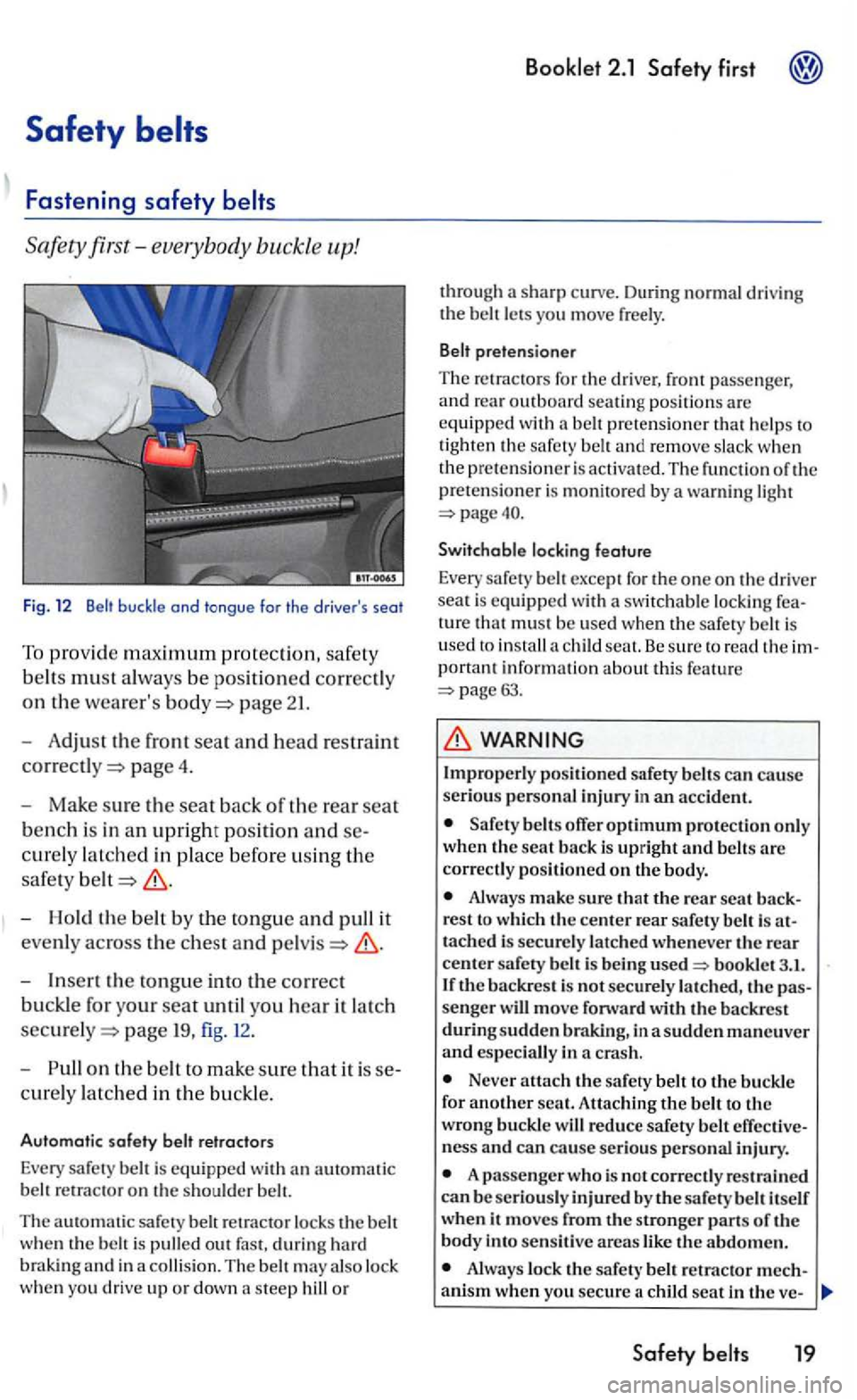
Safety
Safety first-everybody buckle up!
Fig. 12
page 2 1.
- A
djus t the front seat and head restra int
page 4.
-
Make sure the seat back of the rear seat
bench is in an upright position and
cure ly latched in place before using the
safe ty
belt
- Hold the belt b y the to ngue and pull it
eve
nly across the chest and
page 19, fig . 1 2.
-
o n th e belt to make sure that it is se
c u re ly latched in the buckl e.
Automatic safe ty belt retractors
Every safe ly is equi ppe d an o n he s houlder b ell.
The
s a fe ly belt r etrac tor lock s th e belt
w he n the belt is pulled out fast, durin g ha rd
brak ing and in a collision. The ma y also lock when you drive u p or d own a steep hill or
Booklet 2.1
through a sharp curv e. During normal drivin g
the
for the d river, fron t passenge r,
a nd rear out bo ard seating po sition s are equipped wit h a prete n sioner that h elp s to tig h ten the sa fe ty and remove slack w hen
th e pr ete n sioner is act iva te d. Th e functi on of th e
p retension er is monito re d b y a warning light
Switchable lockin g feature
Every safety exce pt for th e one on th e dri ver seat is equipped w ith a switchabl e lock ing ture that mus t be u se d w hen the sa fety is u se d to install a c hild seal. Be sure to read he portant informa tio n abou t thi s fea tur e page63.
WARNING
Improperly posi tion ed safety
offe r optimum protec tion only when the seat back is upright and belts are correctl y po sition ed on the body.
Alwa ys make sure that the rear seat back
r es t to whi ch th e center rear safety is at
tach ed is secu re ly latched whenever th e re ar
cente r safe ty belt is being used bookl et 3.1. If the bac kres t is not s ecurely la tc hed , the passenger wiU move forward with the backre st durin g sudden braking, in a sudden maneuver
and e specially in a cra sh .
Never att ac h the safet y belt to the buckle
for another scat. Atta chin g the belt to the wrong buckle w ill re du ce safety belt ness and can ca use serious perso nal injury.
A passenger who is not correctl y res tra ined can be se riou sly injured by the sa fety belt itself
w hen it moves from th e stronger parts of the body int o sensit ive areas like the abdomen.
Alwa ys lock th e safe ty belt re tra ctor m echanism when yo u secure a child seat in th e ve-
Safety belts 19
Page 111 of 444
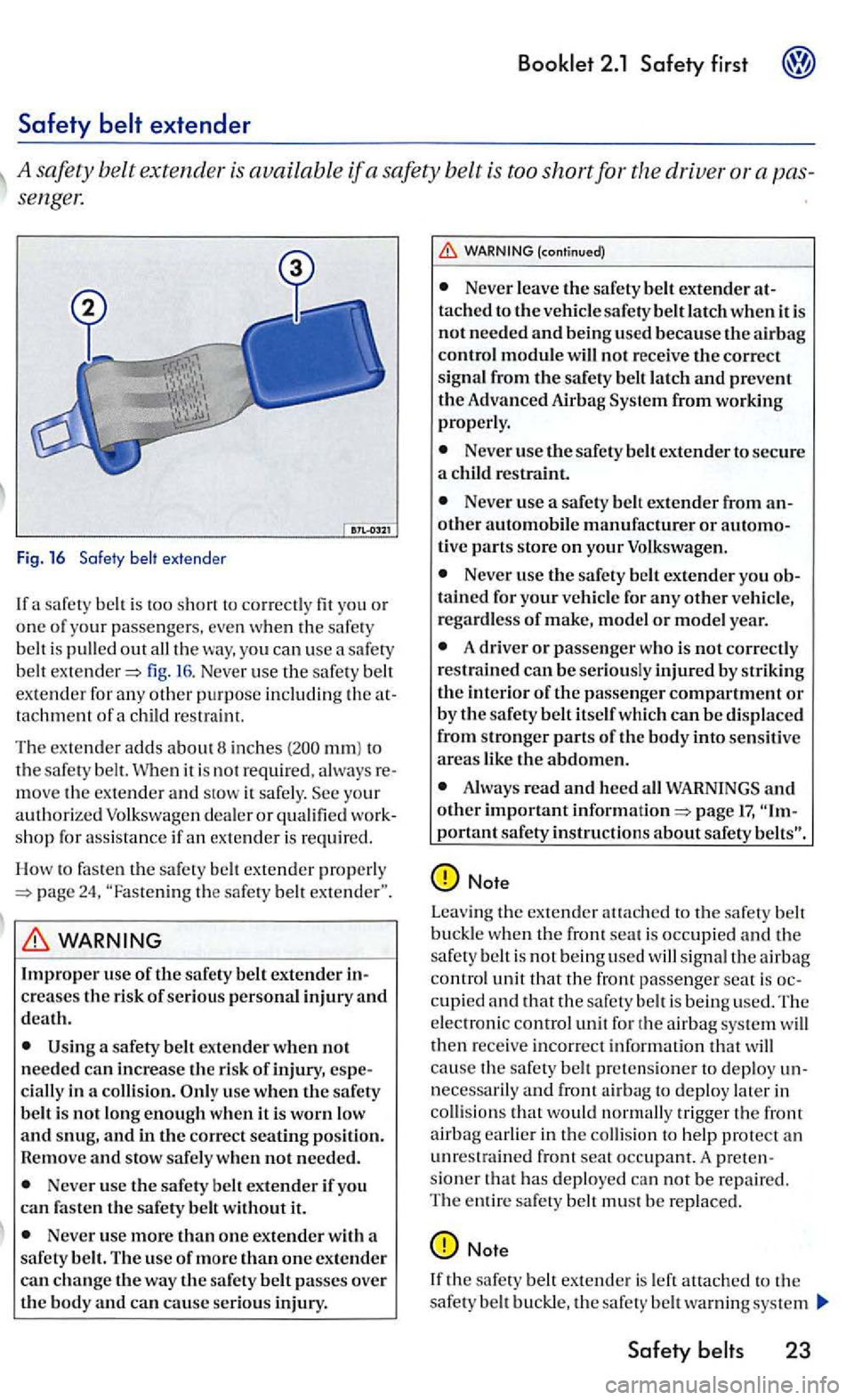
Safety
sengel:
Fig. 16 Safe ty
out fig . 16 . Never use th e safe ty belt
ex tende r for any oth er purpo se includin g th e tachment of a c hild restraint.
Th e
exte nder adds a boutB inches mm) to
the safery belt. Whe n it is not require d , always
s hop for a ss is tan ce if an extende r is requ ired .
H ow to fas te n the s
afety belt extender properly 24, th e sa fe ty belt
crea ses the risk of seriou s personal injury and death.
a safery belt exten de r w hen not needed can increase the risk of injury , cially in a collision. it is worn low
and snug, and in the cor rec t seating position.
R emove and sto w safe ly when not needed.
Never use the safet y belt extender if yo u
ca n fasten the sa fety belt without it.
Never use more than one extender with a
safery be lt. The use of m ore than one extender c a n ch ang e the way the sa fe ty belt passes over
the body and can cause se rious injury .
Never leave the saferybelt extender ta ched to the veh icle safe ty belt latch when it is not needed and being used because th e airbag control module will not re ceive the correc t
s ign al from the safety b elt la tc h and prevent the Advanc ed Airbag from working properly .
Never use the safe ty belt extender to secure
a child restraint.
Never use a safery belt ex tender from
Nev er u se the safery belt extend er yo u tained for your vehicle for any other vehicle,
regardless of make, model or model year.
A driver or pass enger w ho is not correct ly
re strained can be seriously injured b y striki ng the interior of the passe ng er compartment or by the safery b elt its elf whi ch can b e di spla ced
from stronger parts of the body into se nsiti ve areas lik e th e abdomen.
Always read and heed all WARNINGS and other important pa ge
signal th e airbag
co ntrol unit that the front passenge r seat is
ca use the s afery belt prete nsio n er to deploy necessarily and fron t to deplo y la ter in
collision s th at would trigge r the front
a irb ag earlie r in th e to help pro tect an unrestrain ed front seat occ upant. A sioner that has dep loyed can not b e repair ed.
T he entire sa fety belt mu st b e rep laced.
Safety
Page 112 of 444
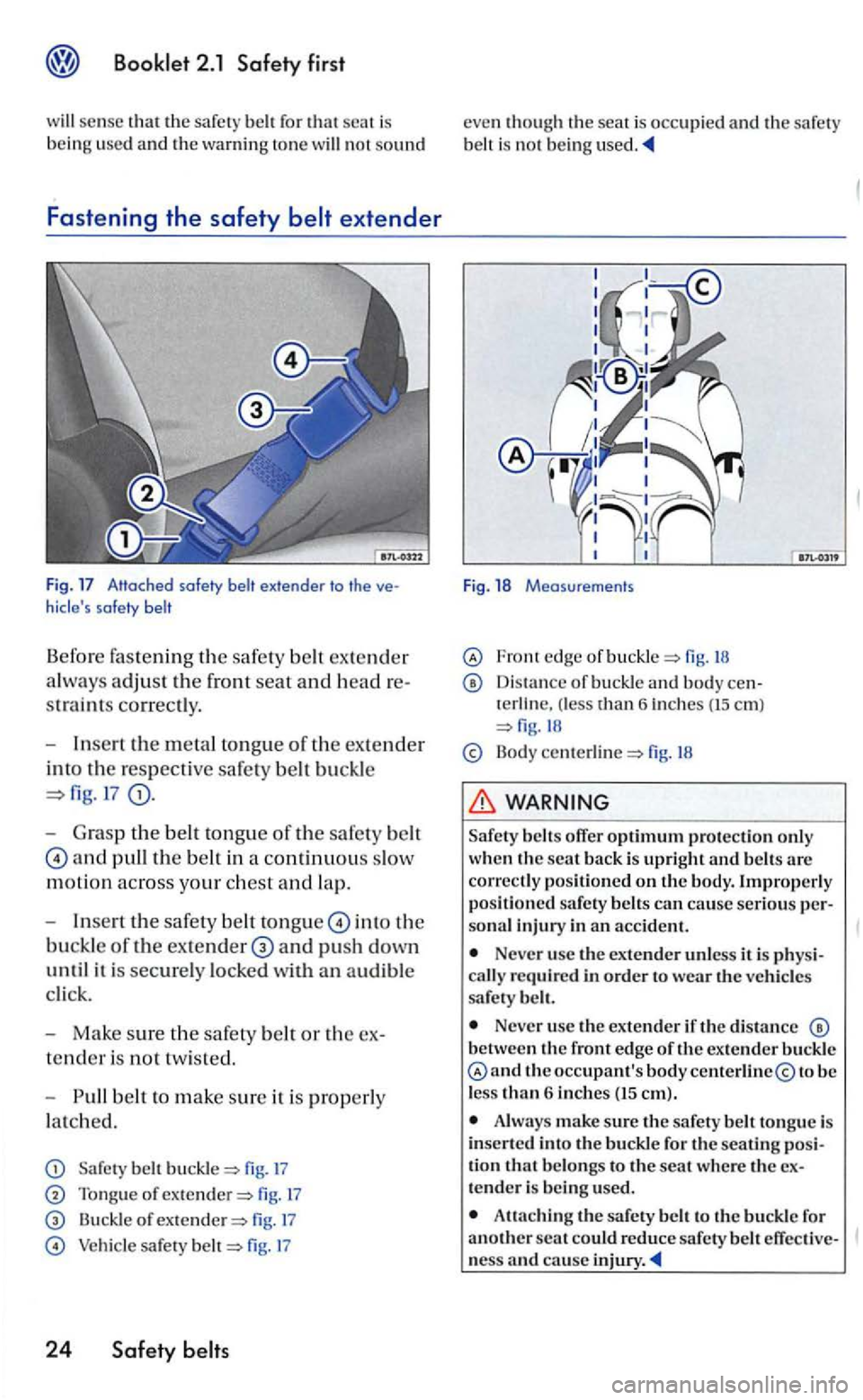
used and the warnin g to ne will no t sound
Fastening the safety
extender to the hide's safety belt
B efor e fastening th e sa fe ty ex tender
a lwa ys adjust th e front seat and hea d str aint s correctly.
- In
sert the m etal ton gu e of th e ex tender
into th e res pectiv e safety belt buckle
- Gra sp th e belt tongue of th e s afet y belt
and pull the belt in a continuous s low
motion across you r chest and la p .
- Inse
rt the safe ty belt ton gue into the
buckle of th e ex tender and push down
until it is secure ly lo cke d with an audibl e
cli ck.
- Make s
ure th e safe ty belt or th e
tender is no t tw is ted.
-
Sa fe ty belt buc kle fig . 17
Ton g ue of ex te nder fig. 17
Buckle o f ex te nd er fig. 17
fig. 17
24 Safety
ev en th oug h the seat is occupied and the safety
belt is no t being used.
Fig. 18 Measurements
Fro nt edge of buckle fig. 18
Distanc e of buckle and body (les s than 6 inches (15 em ) fig.
Body centerlin e
WARNING
belt s offer optimum protection only
when scat back is upright and b e lts are correctly positioned on body. Improperly
po sition ed safety belts can cause serio us
u se the extender unless it is ca lly required
Never use the extend er if the distan ce betwee n the front edge of the ex tende r buck le th e occupant's body centerlin e@ to be l ess than 6 inches (15 em).
A lwa ys make sure safety belt tongu e is
insert e d into the buckl e for the seating tion that belongs to the seat wh ere the tende r is being used.
Attaching t11e sa fety be lt to the buckle for
ano ther seat could reduce safe ty belt ness injury.
Page 133 of 444
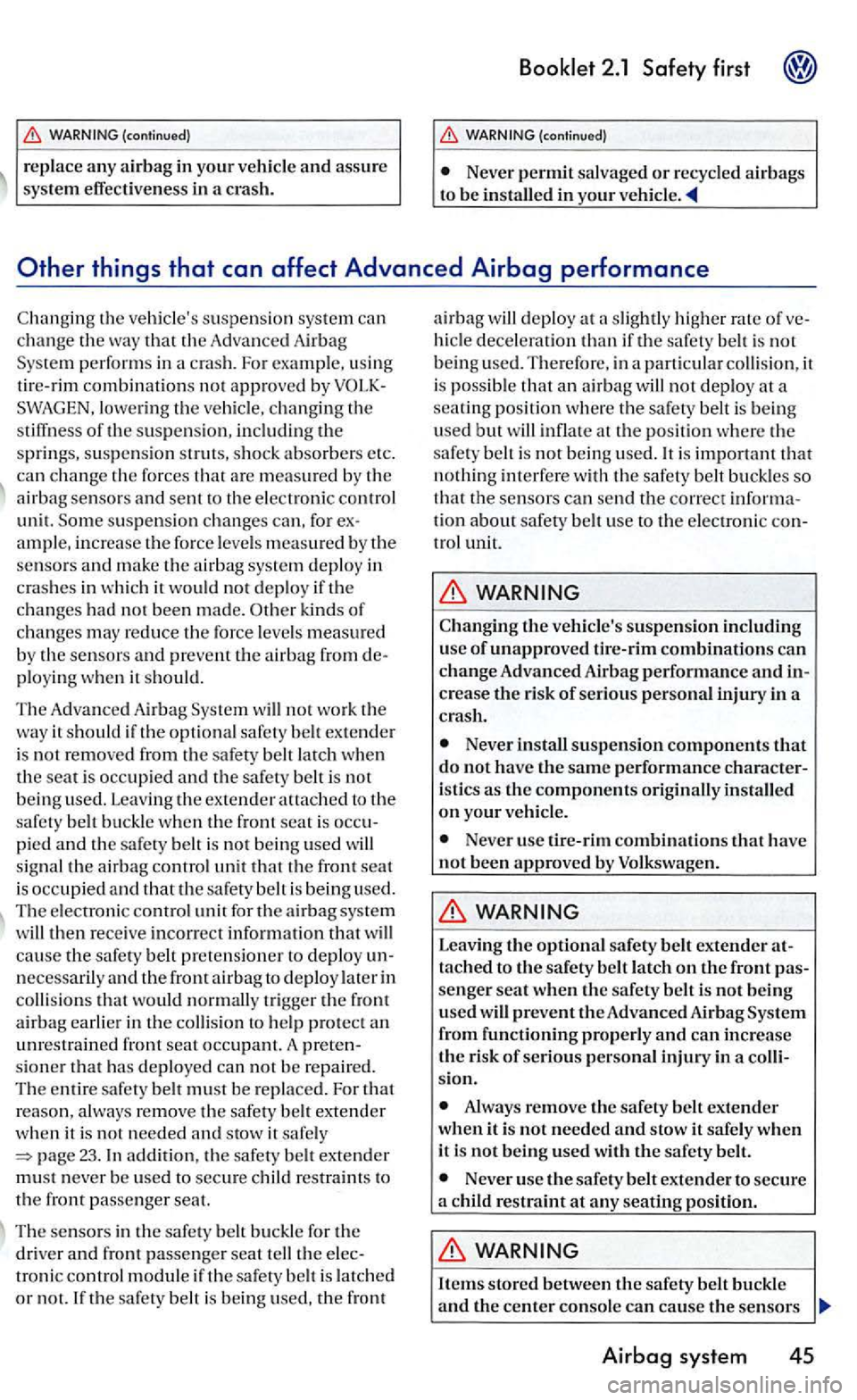
replace any airbag in your vehicle and assure system effectiveness in a crash.
Booklet 2.1 Safety first
Never permit salvaged or recycled ai rb ags
to be installed in your
low ering th e veh icle, changing the
s tiffness of th e suspe nsion , including the spring s, suspe nsion struts, shock absorber s etc.
ca n change th e forces that are meas ured by th e
air bag senso rs and sen t to the electron ic control
unit. s u sp ensio n chang es for ample, increase the force level s m eas ured by the
sensors and make the airb ag system deploy in
cras hes in wh ic h it wou ld no t dep loy if th e
c h a nges had no t bee n made. kind s of ch a nges may reduce the force leve ls mea sured by the senso rs and preve nt the airbag from ploying whe n it should.
The Advanced Airbag will not work the
way it s houl d if th e o ptional safety belt exte nder is not removed from the safety belt latch when
the seat i s occup ie d and the sa fe ty belt is not bei ng used. Leaving th e extender attach ed to the safety belt buck le when the front seat is
s ig na l the airbag control unit that the front seat is occup ied and that the sa fety belt is being used. The elec tron ic co ntro l unit for the airbag system
will then rece ive incorrect information that will cause the safe ty belt pretens ioner to deploy
has deployed can not be re pair ed.
T he entir e safety belt must be rep laced . For that
rea son, a lways re move the sa fety belt exte nde r
w hen it is not nee ded and stow it sa fely
23. In ad d ition, the safet y belt extender must never be used to secure child rest raint s to
th e front passenge r seat.
T he se ns
ors in the safety belt buckle for the driver and front passenge r seat tell th e troni c control module if the safe ty belt is latc hed or If th e sa fe ty belt is being used, the front airbag
will deploy
at a sl ightly highe r rate of hi cle dece leration than if the sa fe ty belt is not
b eing used . Therefore , in a particular collision, it
i s possible that an airbag will not deplo y at a seatin g position where the safety belt is being
u sed but infla te at the position where the safe ty belt is not bei ng use d. It is important that n othing interfere with the safety belt buck les so
that the sensors can send the correct tion abou t safety belt use to the elec tron ic
C hanging the ve hicl e's suspension including
us e of unapproved tire-rim combinations ca n change Advanced Airbag performance and crease the risk of se rious personal injury in a
c ras h.
Never install s uspension components that do not h ave the same performance ist ics as th e components originally in stalled on your ve hicl e.
Never use tire-rim combin a ti o ns th at have not been approved by Volkswage n.
Leaving the optional safety belt extender tached to th e safety belt latch on the front senger seat when the safety belt is not being
u se d will prevent the Adva nced fro m functioning properl y and ca n in crease the risk of se riou s pe rso nal injury in a
Always remove the safety belt extende r
w hen it is not needed and stow it safely whe n
it is not bei ng used with the safety belt.
Never use th e safety belt exte nder to secure
a c hild restraint at any seating position.
buckle and the cente r conso le can cause the sensors
Airbag system 45
Page 152 of 444
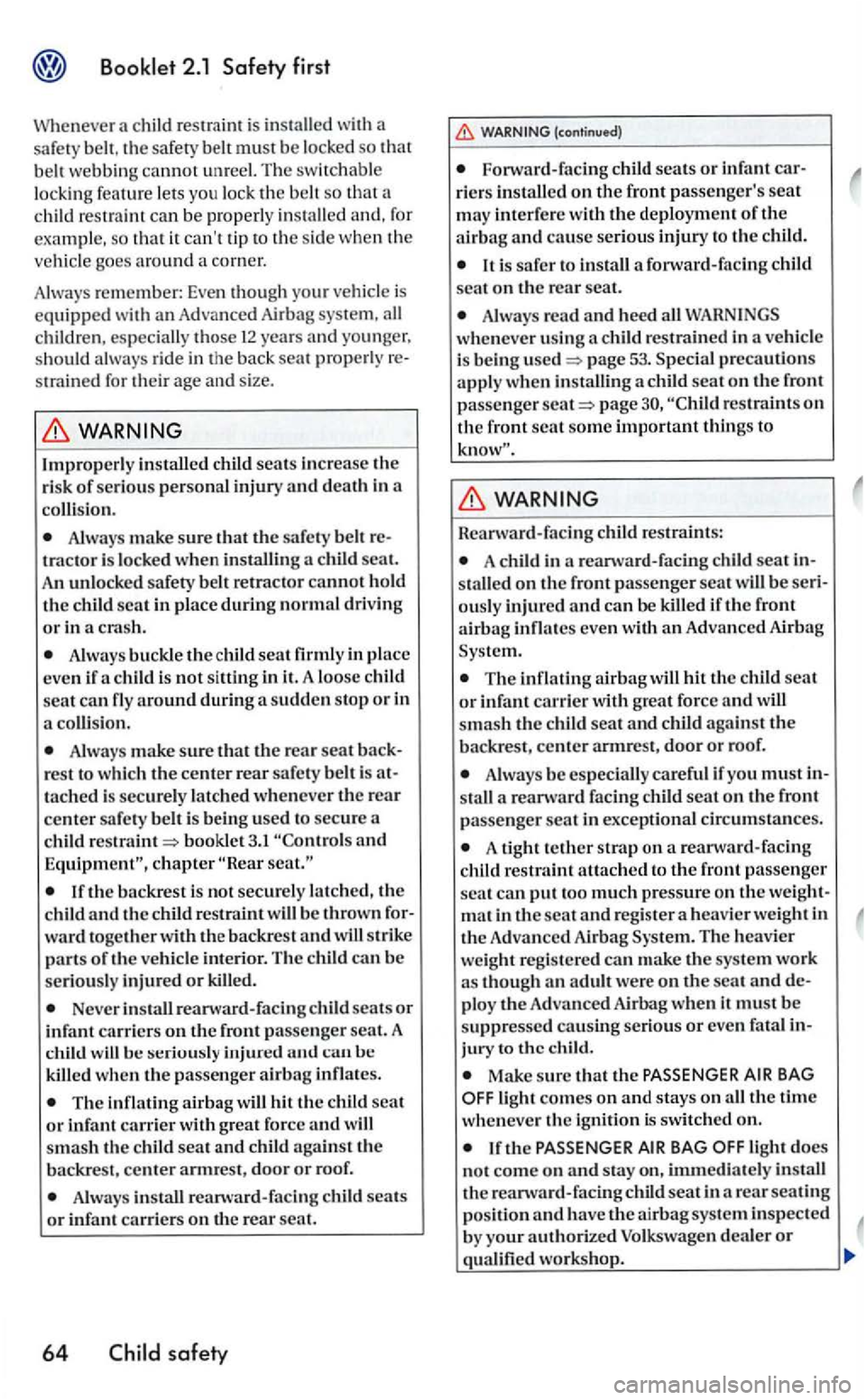
child restrain! is in stalled with a
sa fety belt , th e safety belt must be locke d so
strained for th eir age and size.
colli sio n.
Always make sure th at the safety b elt tracto r is locke d w hen in stallin g
Always buckle the seat firml y in plac e
eve n if
can fly around during a sudden sto p or in
Always rest to whi ch the ce nter rear safety belt is tach ed i s sec ure ly la tc h ed wh eneve r th e rea r
cente r sa fety belt is being use d to secure a
c hild booklet 3.1 and
ward together with the backrest and w ill strik e
part s of th e ve hicl e int eri or. T he c hild can be seriou sly injure d or kill ed .
Never ins tall rearw ard -faci ng c hild scats or infant carri ers on the f ront passe nge r sc at. A
kill ed w hen the passe nge r airb ag inflates.
The inflatin g air bag will hit the child scat or infa nt carrier with great force and w ill
smas h th e child seat and child against the
b ackrest, ce nter armrest , d oo r or roof.
Always instal l rearward -faci ng c hild seats or infant carri ers on th e rear scat.
64 safety
Forward -facin g c hild seats o r infant ri ers insta ll ed on the fr ont passe nger' s sca t
m ay interfere with the de plo ym ent of the
a irba g cause seriou s injury to the c hild.
Alw ays read and hee d all whenever u sin g a c hild restrain ed in a vehicle
i s be in g page 53.
page
Rearward -fa cin g restrai nts:
child in a reanva rd-facin g c hild seat sta ll ed on the front p asse nger sea t will b e ously inju red and ca n be killed if the fro nt
a irbag infl ates eve n with an Advan ce d Airb a g
Syste m.
The inflatin g airbagwill hit the child seat or infant carrier with great force and w ill
smas h the c hild seat a nd child against the
b ackrest, ce nter armres t, d oor o r r oof.
Always be es peci all y care ful if yo u must s tall a reanvard faci ng seat on the front pa sse nge r seat in ex ce ptional circumsta nces.
A tight te th er strap on a rearward- fac ing
c hild restraint attache d to the front p asse nger
sca t can put too muc h pressure o n the mat in the seat and reg is ter a heav ie r weight in the A dva nce d Airb ag Sys te m. The hea vie r
w eig ht reg is te re d ca n mak e th e sys te m work
as
thoug h an adult were o n the scat and ploy the A dva nced Airba g wh en it must be suppresse d causing serio us or eve n fa ta l ju ry to the child .
Make sure that th e PASSENGER AIR BAG Light comes o n and s tays on all the tim e
wh en ever th e ig niti on is s wit ch ed on.
dealer o r